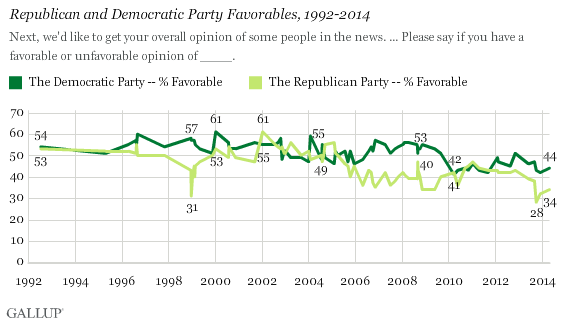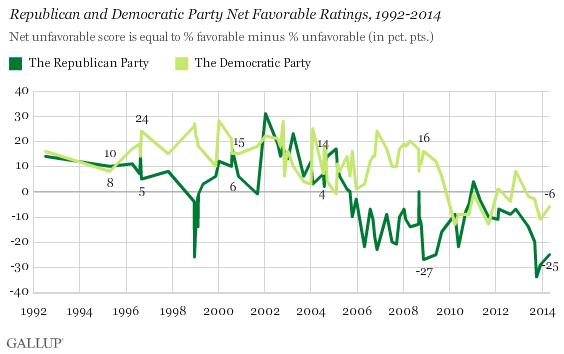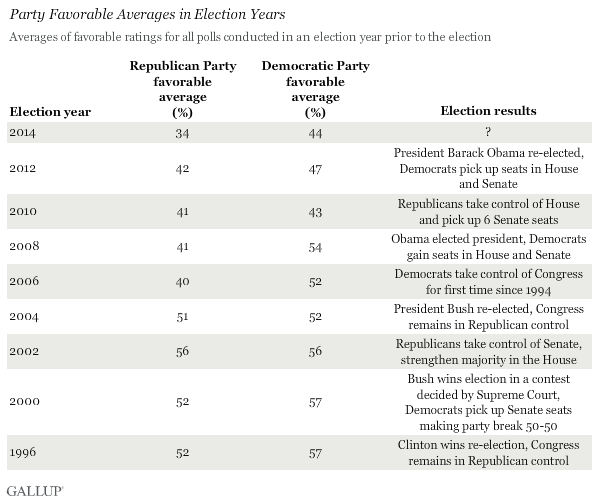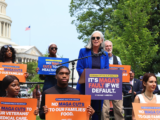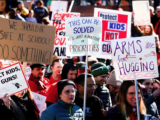By Glynn Wilson –
More Americans view the Democratic Party favorably than the Republican Party, although neither party is viewed favorably by a majority of the American people.
According to the latest Gallup poll, 44 percent of Americans give the Democratic Party a favorability rating, while only 34 percent of those surveyed view the Republican Party favorably.
Americans’ opinions of both parties have not changed much since December 2013, although the Republican Party’s favorability has improved modestly from the all-time low of 28 percent observed during the government shutdown last October.
“Still, if the Republicans’ current favorability ratings hold, they will be the lowest ever for either party in an election year,” Gallup says in its analysis.
The Republican Party now has a net public opinion rating of minus 25, with only 34 percent of the people viewing it favorably and 59 percent giving it an unfavorable rating.
“The GOP has suffered from mostly negative or low positive scores since October 2005, about a year into President George W. Bush’s second term, when his approval rating began to sink,” Gallup says.
The Democrats’ net rating stands at minus 6, with 44 percent of the people viewing it favorably and 50 percent giving it an unfavorable rating.
“The Democrats’ net favorable rating throughout Barack Obama’s presidency has alternated between episodes of positivity, such as in 2009 and in late 2012, and negativity, such as throughout 2010 and 2011,” Gallup says. “Prior to Obama’s presidency, the Democratic Party had nearly always been viewed more positively than negatively — averaging a 15-point net favorable rating between 1992 and 2008, despite holding Congress or the presidency for no more than half of that time. In political polling parlance, both major political parties are currently ‘upside down’ with the American public.”
It has been almost a decade since Americans simultaneously viewed both parties more favorably than not, and that was in the summer of 2005.
Party With Higher Favorables Not Always Election Winner
While the Democrats currently lead their Republican rivals in overall favorable ratings, even if they are able to maintain this position throughout the 2014 midterm election cycle, “it hardly augurs success for the party,” Gallup says. “There have been several instances in the eight elections from 1996-2012 in which the more popular party has failed to dominate the November elections.”
Election results appear to more clearly favor one party in years when a majority of the country sees that party but not the other in a favorable light, according to Gallup, citing 2006 and 2008, when the Democrats enjoyed majority average favorable ratings and only about four in 10 Americans had a favorable opinion of the Republican Party.
“Both elections were Democratic sweeps, with the 2008 elections giving Democrats control over both Congress and the White House for the first time since 1994,” Gallup says.
On the other hand, the Republican rout in the 2010 midterms was not foreshadowed in the party’s 41 percent average favorable rating that year, according to Gallup, which was essentially no better than perceptions of the party in the election years of 2006 and 2008.
“However, views of the Democratic Party in 2010 had tumbled from the 2008 average by 11 points, indicating growing disenchantment with the ruling party,” Gallup says. “Even though the Democrats’ 2010 average favorable rating was an insignificant two points higher than the Republicans’, Republicans won the House handily and gained Senate seats.”
Gallup’s Implications
“The fact that the public does not see either party positively suggests both parties will likely face some difficulties in convincing voters to give them their support this November. But for now, the Republican Party may have the most reason for concern,” Gallup says. “If its favorability rating hovers in the range in which it currently resides, this will be the lowest favorability rating either party has ever held in an election year. Given the GOP’s big hopes this fall — including claiming a Senate majority — this low rating could cast cold water on these lofty objectives.”
Survey Methods
Results for this Gallup poll are based on telephone interviews conducted April 24-30, 2014, on the Gallup Daily tracking survey, with a random sample of 1,513 adults, aged 18 and older, living in all 50 U.S. states and the District of Columbia. For results based on the total sample of national adults, the margin of sampling error is plus or minus 3 percentage points at the 95 percent confidence level.


